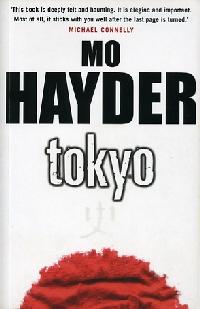All's unfair in love and war
Obsessions with Japan's uneasy history
By Mark Schreiber
A version of this review appeared as
"All's unfair in love and war" in
The Japan Times, The Asian Bookshelf, 23 May 2004
Hal Gold, Neutral War, 2003
Mo Hayder, Tokyo, 2004

Hal Gold Novels that tantalize readers by intertwining known facts about the Pacific War with historical what-ifs and maybes bring to mind such entertaining past works as Claire Taschdjian's The Peking Man is Missing (1977), about the disappearance of the world's most famous fossils in December 1941; Roger Pulvers' The Death of Urashima Taro (1981), in which a young Australian reporter in Tokyo researches the bloody August 1944 breakout attempt by over 1,000 Japanese POWs from the Cowra, Australia, prison camp; and Nagasaki Six (1997), Guy Stanley's novel about the fate POWs in the atomic-bombed city. What's in a numberIn Neutral War, Hal Gold has researched the life of Swedish diplomat Widar Bagge, who passed away in 1970, and transformed his protagonist into the Forrest Gump of the 1920s, '30s and '40s. The character lurks in the background of the major events leading up to, and during, World War II: bitter army-navy rivalry, the Axis alliance, the battle of Nomonhan, Pearl Harbor, Unit 731 and the peace feelers that led to Japan's surrender. Bagge, in over 400 pages, encounters a stream of major historical figures, including his old poker and shogi (Japanese chess) partner Adm. Isoroku Yamamoto -- an early proponent of naval air power and architect of the attack on Pearl Harbor. Yamamoto's supposed obsession with the numbers 4 (he was born on April 4) and 11 (the name Isoroku includes the kanji characters for 5 and 6), and the recurrence of these numbers in the major events in his life, are raised repeatedly -- perhaps a little too often. Gold also injects a few of the unsubstantiated rumors circulated after the war, such as the theory that Yamamoto may have already been dead, perhaps by his own hand, at the time American pilots shot down his transport plane in 1943. Puccini connectionIn addition to providing a romantic interlude, Mariko Hiraoka, the young schoolteacher with whom Bagge conducts a discreet romance, lends a voice for ordinary Japanese to express their misgivings over escalating militarism. Bagge has affectionately nicknamed Hiraoka "Butterfly," after her accomplished swimming stroke; the connection between this nickname and the tragic heroine in Giacomo Puccini's opera is by no means coincidental. After Bagge departs Japan in April 1945, Mariko is imprisoned for her refusal to indoctrinate students with nationalist fervor. The two are reunited briefly after the war, but their final parting is disheartening as Gold, in an original twist on the Puccini tale, takes aim at his protagonist's inability to depart from his diplomatic neutrality and give greater priority to saving lives. Even by the standards of historical fiction, Gold's knowledge of the period is exceptional. In a succinct and thoughtful afterward, Gold denotes which parts of his book are based on known facts, which are speculation and which were fictionalized to flavor the narrative. Neutral War earns top grades for its detailed research and readability, authentically conveying the oppressive aura of the times while never resorting to weepy melodrama. |

Mo Hayder From her teens, the unremarkable young Englishwoman known only as Grey -- actually a description rather than her real name -- has been obsessed with tracking down the details of an atrocity that supposedly occurred when the Japanese Army overran the Nationalist Chinese capital of Nanjing in December 1937. So far her search has taken "nine years, seven months and 18 days." Now she's in Tokyo where, almost penniless, the naive young woman spends her first night sleeping on a bench. Chance and other encountersThrough a chance encounter with Jason, a charismatic young American, Grey reluctantly accepts lodgings at a decrepit house in Takadanobaba and employment at a posh hostess club -- as author Mo Hayder admits having done during her own sojourn in Japan. Grey's first-person, present-day narrative alternates with flashbacks set in Nanjing in 1937, which are related in the first person by Shi Chongming, a Chinese who presently happens to be a visiting researcher at University of Tokyo. Shi is not at all happy to encounter an eccentric young British woman who asks him to spill his reminiscences, but makes the devil's bargain with Grey, agreeing to share his memories of a wartime horror in exchange for Grey's investigation of Junzo Fuyuki, a powerful gang boss in his 80s who, by coincidence, is a frequent patron of the club where she works. Bizarre link revealedThe old gangster's secret source of rejuvenation is stolen from his apartment, setting off Ogawa -- a hulking, androgynous nurse-cum-bodyguard capable of horrific violence -- on a frantic search to recover it. The book's horrifying climax converges on the old house where Jason and Grey reside. The perpetrator and victim of the past assume their present-day identities, and the bizarre link between the 1937 atrocity and Grey's physical disfigurement is finally revealed. The unorthodox mixture of conventional narrative and modern Gothic may dilute the intended message of Tokyo, but it definitely stands out as an unusual literary effort. |